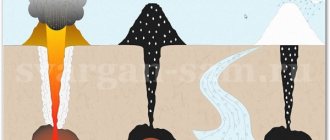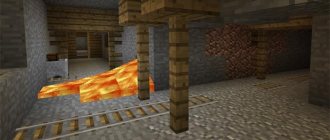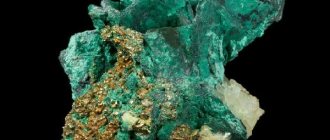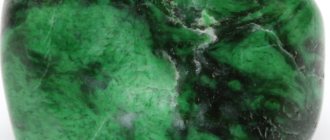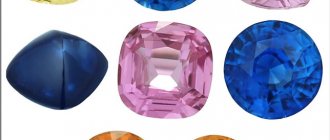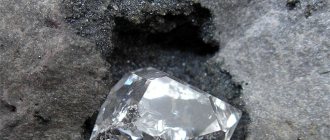Everyone knows that diamond is the most precious stone on earth. It is unique in that it is the hardest, most radiant and sparkling among minerals; its external characteristics are not subject to time, mechanical damage and even fire. Both thousands of years ago and now, diamonds attract humanity, beckoning with their cold beauty. Processed diamonds not only produce magnificent diamonds that adorn luxury jewelry, they are also (due to their properties) used in many industrial sectors. There are enough deposits where diamonds can be found in Russia to say that our country is a diamond power. In this article we will tell you more about the extraction of such a useful and beautiful mineral. So, further about where diamonds are mined in Russia: cities, location of deposits.
Diamonds in nature
In the upper mantle of the Earth, at a depth of more than 100-150 km, under the influence of high temperatures and enormous pressure, pure carbon atoms from the graphite state are modified into crystals, which we call diamonds. This crystallization process takes hundreds of years. After spending several million years in its depths, diamonds are brought to the surface of the earth by kimberlite magma during volcanic explosions. With such an explosion, so-called pipes are formed - kimberlite diamond deposits. The name “kimberlite” comes from the African town of Kimberley, in the area of which diamond-bearing rock was discovered. Nowadays, there are two types of diamond deposits: primary (lamproite and kimberlite) and secondary (placers).
Diamonds were known to mankind three thousand years before our era; the first mentions of them were found in India. People immediately endowed diamond with supernatural properties, thanks to its indestructible hardness, brilliance and transparent purity. It was accessible only to selected persons who had power and authority.
Diamonds from space
September 2012 media releases announced information that Russian scientists had declassified data about the largest “alien” diamond mines on the planet. The Popigai deposit is known to the world for its sensational occurrence on the border of the Krasnoyarsk Territory and Yakutia.
This is a meteorite crater, the result of a cosmic body falling into graphite rocks. Under high pressure and heating, the transition of graphite into dense structural carbon modifications occurred. This is how crystals called impact diamonds were formed.
These crystals are very different from kimberlite crystals. They have a needle or plate shape. And they are not at all suitable as a material for jewelry; they are used exclusively for technical purposes.
Diamond producing countries
Since each diamond is unique in its kind, it is customary to separate their accounting among world countries according to production volumes and in value terms. The bulk of diamond production is distributed among only nine countries. These are Russia, the Republic of Congo, Botswana, Australia, Canada, Angola, South Africa, Zimbabwe and Namibia.
In value terms, the leaders among these countries are Russia, African Botswana and Canada. Their total diamond production accounts for more than 60% of the value of the world's mined diamonds.
For incomplete 2021 (according to the latest data), Russia takes first place in terms of production volumes and value. Its share in value terms accounts for about 40% of total world production. This leadership has belonged to Russia for several years.
The first diamond in the Russian Federation
Now in more detail about production in our country. When and where did diamond mining in Russia first begin? This happened in the 19th century, in the summer of 1829, the serf teenager Pavel Popov, panning for gold at the Krestovozdvizhensky gold mine in the Perm province, found an incomprehensible pebble. The boy gave it to the caretaker and after assessing the precious find, he was given his freedom, and all other workers were told to pay attention to all the transparent stones. So two more diamonds were found. Humboldt, a former German geologist nearby, was told about the place where diamonds are mined in Russia. Then the development of the diamond mine began.
Over the next thirty years, about 130 diamonds were discovered, weighing a total of 60 carats. In total, before 1917, no more than 250 precious stones were found in Russia, where diamonds were mined in the Urals. But, despite the insignificant number, they were all of excellent beauty. These were stones worthy of decorating jewelry.
Already in 1937, large-scale expeditions were organized in Soviet Russia to explore Ural diamonds, but they were not crowned with great success. The placers found were poor in precious stone content; primary diamond deposits were never discovered in the Urals.
Siberian diamonds
Since the 18th century, the best minds of our country have wondered where the diamond deposits are in Russia. The great Russian scientist of the 18th century, Mikhail Lomonosov, stated in his writings that Siberia could be a diamond-bearing region. He outlined his assumption in the manuscript “Diamonds Could Have Occurred in the Northern Lands.” However, the first Siberian diamond was found at the end of the 19th century on the Melnichnaya River, near the city of Yeniseisk. Due to the fact that it weighed only two-thirds of a carat, and also due to a lack of funding, exploration of other diamonds in the area was not continued.
And only in 1949 in Yakutia on the Sokolinaya Spit, near the village of Krestya in the Suntarsky Ulus, the first Siberian diamond was found. But this deposit was alluvial. The search for indigenous kimberlite pipes was crowned with success five years later - the first pipe not located in Africa was found near the Daldyn River by geologist Popugaeva. This was a significant discovery in the life of our country. The name of the first diamond-bearing pipe was given in the Soviet style of that time - “Zarnitsa”. The next to be discovered were the Mir pipe and the Udachnaya pipe, where diamonds are still mined in Russia. By the end of 1955, 15 new diamond pipe deposits appeared in Yakutia.
Yakutia, or as the locals call this region, the Republic of Sakha, is the place where gold and diamonds are mined in Russia. Despite the severity of the climate, it is a fertile and generous region, giving our country natural resources.
Below is a map that clearly shows where these precious stones are mined in Russia. The darkest territories are the places where there are the largest number of deposits, and the diamonds themselves are the most expensive in value. As you can see, most of the pipes are concentrated in the Republic of Sakha (Yakutia). There are also diamonds in the Krasnoyarsk Territory, Irkutsk Region, the Republic of Karelia, the Arkhangelsk and Murmansk Regions, the Perm Territory, the Komi Republic and so on.
Geography of occurrence of diamond rock
Diamond is a rare, but widespread stone
Diamond is a rare, but widespread stone. It is considered one of the most significant and valuable minerals.
Diamond deposits are present on all continents except Antarctica. There are more than sixty large diamond deposits under development around the world.
Clusters of diamonds are located in geologically stable parts of continents, as there are suitable conditions conducive to the formation of the mineral. At a depth of 100-200 kilometers, at a temperature of 1100-1300 °C, under a pressure of 35-50 kilobars, the carbon lattice of graphite is transformed into the carbon lattice of diamond. The duration of the process is unknown.
During volcanic eruptions, kimberlite or lamproite magma, which contains diamonds, pours onto the surface of the earth. Only 3 to 4 percent of pipes may contain diamonds.
Initially, diamonds were found in river accumulations in India and Brazil. They were found from time to time during the washing of gold-bearing sand.
The first diamond deposit was discovered in southern Africa in the Kimberley province. It was this name that was taken to designate the diamond-bearing rock.
To date, diamond deposits have been discovered in more than 35 countries. In 25 of them, industrial development of deposits is underway.
Diamond mining in Africa
The richest continent in terms of diamond deposits is Africa, the most developed country of South Africa is in fourth place in the list of leading countries in the diamond industry. $1.3 billion worth of gemstones are mined here every year.
Another African country that has significant deposits of diamond ore is Botswana. The diamonds mined here are of high quality; the country has the largest number of mines, industrial exploration of which began in 1971. The main exporters of precious stones mined here are the countries of Western Europe and the USA.
The African continent has another country with large deposits of diamonds - Angola. Diamond production in the country accounts for 15% of the total world volume and is in fifth place in the ranking. The largest deposit is Fukauma, the cost of diamond production per year is $1.2 billion.
The Diavik quarry in Canada was opened in 2003 and produces about 1,500 kg. diamonds per year
The North American continent is in third place in terms of diamond reserves. The main production is carried out by Canada; it is the leader not only in production volumes, but also in export volumes - $1.4 billion. The largest mine in the country is Ekati.
The largest continent, Eurasia, is also rich in diamond deposits. Russia ranks second in the world in terms of production of these precious metals, the total value is estimated at $2 billion per year. The main deposits in Russia are located in the Republic of Sakha (Yakutia), as well as in the Perm and Arkhangelsk regions.
The South American continent has long been the leader in diamond production. The very first deposits were discovered in Brazil in 1725; this country was the leader in the diamond mining industry, however, with the active development of African deposits, it began to significantly lose its position.
Argyll Diamond Mine
Diamonds are mainly found in kimberlite pipes. Diamond-bearing lamproite rocks are quite rare. The continent of Australia is rich in lamproite pipes, but only one Argyle lamproite pipe located there is in industrial development.
Of the diamonds mined there, 95% are technical and only 5% can be used in jewelry. The Argyle pipe is also the largest supplier of pink diamonds, which are quite rare.
In Russia, the first diamond was found in 1829 in the Perm province in the Urals by the serf Pavel Popov.
The Udachnaya pipe, the richest in diamond content
Since then, the search for diamond deposits in Russia has been carried out for another century and a half and, in 1954, geologist Larisa Anatolyevna Popugaeva discovered the first Russian primary diamond deposit.
A kimberlite pipe was found in Yakutia in the Daldyn-Alakit region. It was given the name “Zarnitsa”. The discovery of this pipe was the beginning of the entire diamond mining industry in Russia.
A year after the discovery of the Zarnitsa pipe, 10 more kimberlite pipes were found. Among them was the Udachnaya pipe, which was richest in diamond content. Today there are 12 mines in development.
Mirny is the city with the most diamonds in Russia
In the summer of 1955, geologists searching for kimberlite pipes in Yakutia saw a larch tree with exposed roots. This fox dug a hole here. The color of the scattered earth was bluish, which is a characteristic feature of kimberlite. The geologists were not mistaken in their guesses, and after some time they sent a coded message to the top Soviet leadership: “We smoked the pipe of peace, the tobacco is excellent!” A year later, in the west of Yakutia, large-scale development of the Mir kimberlite pipe begins, similar to quarry excavations.
Around a huge quarry in the form of a funnel, a village is formed, named in his honor - Mirny. Within two years, the village turns into the city of Mirny, today it is a city with a population of more than three tens of thousands of residents, 80% of whom are employed in the diamond mining enterprise. It can rightfully be called the diamond capital of Russia, because millions of dollars worth of diamonds are mined here every year.
Now it is the largest quarry not only in Russia, where diamonds are mined, but throughout the world. The depth of the huge quarry is 525 meters, its diameter is about 1200 meters, the quarry could easily accommodate the Ostankino TV tower. And when descending to the center of the quarry, the length of the serpentine road is more than 8 kilometers.
Below in the photo is just this diamond quarry (Mirny, Yakutia).
Photo facts. Diamonds are mined here around the clock. What does a kimberlite pipe look like?
With the permission of the author, we publish photographs and invite readers of the information portal to dive into the Yakut kimberlite pipes, where 99% of Russia’s diamonds are mined.
How are diamonds mined? Mirny and Nyurbinsky mining and processing plants.
Slava Stepanov, gelio.livejournal.com.
Diamonds were formed more than 300 million years ago. Kimberlite magma formed at a depth of 20−25 kilometers. Magma gradually rose along faults in the earth's crust, and when the upper layers could no longer contain the pressure of the rocks, an explosion occurred. The first such pipe was discovered in South Africa in Kimberley - that’s where the name came from. In the mid-50s, the richest primary diamond deposits were discovered in Yakutia, where about 1,500 kimberlite pipes have been discovered to date. The development of deposits in Yakutia is carried out by the Russian company, which produces 99% of diamonds in the Russian Federation and more than a quarter in the world.
How are diamonds mined? Mirny and Nyurbinsky mining and processing plants.
Slava Stepanov, gelio.livejournal.com.
Mirny is the diamond “capital” of Russia, located in Yakutia (Sakha) 1200 kilometers from Yakutsk. The Mir diamond-bearing pipe, discovered by geologists in the summer of 1955, gave its name to a workers’ settlement that grew up in the taiga and became a city 3.5 years later.
How are diamonds mined? Mirny and Nyurbinsky mining and processing plants.
Slava Stepanov, gelio.livejournal.com.
The population of the city is about 35 thousand people. About 80% of this population works in enterprises associated with the group.
How are diamonds mined? Mirny and Nyurbinsky mining and processing plants.
Slava Stepanov, gelio.livejournal.com.
Lenin Square is the center of the city.
How are diamonds mined? Mirny and Nyurbinsky mining and processing plants.
Slava Stepanov, gelio.livejournal.com.
Mirny Airport. The city is supplied with food and consumer goods in the following ways: aviation, shipping supplies (for the period while navigation is open on the Lena) and along the winter road.
How are diamonds mined? Mirny and Nyurbinsky mining and processing plants.
Slava Stepanov, gelio.livejournal.com.
Cargo aircraft Il-76TD avia.
How are diamonds mined? Mirny and Nyurbinsky mining and processing plants.
Slava Stepanov, gelio.livejournal.com.
The headquarters of Russia's largest diamond mining company is located in Mirny. The history of the company began with the Yakutalmaz trust, formed to develop the primary diamond deposits of Yakutia in the early 1950s.
How are diamonds mined? Mirny and Nyurbinsky mining and processing plants.
Slava Stepanov, gelio.livejournal.com.
The main deposit of Yakutalmaz was the Mir kimberlite pipe, discovered on June 13, 1955. Then geologists sent an encrypted telegram to Moscow: “We have lit the pipe of peace. The tobacco is excellent."
How are diamonds mined? Mirny and Nyurbinsky mining and processing plants.
Slava Stepanov, gelio.livejournal.com.
The quarry is located in close proximity to Mirny.
How are diamonds mined? Mirny and Nyurbinsky mining and processing plants.
Slava Stepanov, gelio.livejournal.com.
From 1957 to 2001, $17 billion worth of diamonds were extracted from the deposit, and about 350 million cubic meters of rock were removed. Over the years, the quarry expanded so much that dump trucks had to drive eight kilometers along a spiral road from the bottom to the surface.
How are diamonds mined? Mirny and Nyurbinsky mining and processing plants.
Slava Stepanov, gelio.livejournal.com.
The quarry has a depth of 525 meters and a diameter of 1.2 kilometers, and is one of the largest in the world: the height of it could include the Ostankino TV tower.
How are diamonds mined? Mirny and Nyurbinsky mining and processing plants.
Slava Stepanov, gelio.livejournal.com.
The quarry was mothballed in June 2001 and since 2009, diamond ore has been mined underground at the Mir mine.
Kimberlite pipe in Mirny.
Slava Stepanov, gelio.livejournal.com.
There is an aquifer in the area where the Mir pipe is located. Water is now entering the quarry and thus poses a threat to the mine underneath. Water must be continuously pumped out and directed into the faults that geologists have found in the earth's crust.
How are diamonds mined? Mirny and Nyurbinsky mining and processing plants.
Slava Stepanov, gelio.livejournal.com.
The volume of diamond production at the mine in 2013 amounted to more than two million carats. Resources (including reserves) - more than 40 million tons of ore.
How are diamonds mined? Mirny and Nyurbinsky mining and processing plants.
Slava Stepanov, gelio.livejournal.com.
About 760 people work at the mine. The company operates seven days a week. The mine operates on a three-shift basis, with shifts lasting seven hours.
How are diamonds mined? Mirny and Nyurbinsky mining and processing plants.
Slava Stepanov, gelio.livejournal.com.
Surveyors who determine the direction of excavation through the ore body.
How are diamonds mined? Mirny and Nyurbinsky mining and processing plants.
Slava Stepanov, gelio.livejournal.com.
Nine roadheaders (Sandvik MR 620 and MR360) are used for excavation in the mine. The combine is a machine with an executive body in the form of an arrow with a milling crown, which is equipped with cutting tools - teeth.
How are diamonds mined? Mirny and Nyurbinsky mining and processing plants.
Slava Stepanov, gelio.livejournal.com.
This Sandvik MR360 combine has 72 teeth made of hardened metal. Since the teeth are subject to wear, they are inspected every shift and, if necessary, replaced with new ones.
How are diamonds mined? Mirny and Nyurbinsky mining and processing plants.
Slava Stepanov, gelio.livejournal.com.
To deliver ore from the combine to the ore pass, 8 loading and delivery vehicles (LODs) are used.
How are diamonds mined? Mirny and Nyurbinsky mining and processing plants.
Slava Stepanov, gelio.livejournal.com.
Main converter belt 1200 meters long from the kimberlite pipe to the ore pass skip. The average diamond content exceeds three carats per ton.
How are diamonds mined? Mirny and Nyurbinsky mining and processing plants.
Slava Stepanov, gelio.livejournal.com.
From this place to the bottom of the quarry is about 20 meters. To prevent flooding of the underground mine, a pillar 20 meters thick was left between the bottom of the quarry and the mine workings. A waterproof layer is also laid at the bottom of the quarry, which prevents water from penetrating into the mine.
How are diamonds mined? Mirny and Nyurbinsky mining and processing plants.
Slava Stepanov, gelio.livejournal.com.
The mine also has a water collection system: first, groundwater is collected in special settling tanks, then it is supplied to an elevation of 310 meters, from where it is pumped to the surface.
How are diamonds mined? Mirny and Nyurbinsky mining and processing plants.
Slava Stepanov, gelio.livejournal.com.
In total, the mine operates 10 pumps with a capacity of 180 to 400 cubic meters per hour.
How are diamonds mined? Mirny and Nyurbinsky mining and processing plants.
Slava Stepanov, gelio.livejournal.com.
Installation of the main tape.
How are diamonds mined? Mirny and Nyurbinsky mining and processing plants.
Slava Stepanov, gelio.livejournal.com.
And this is underground work on another pipe - International (Inter). It is located 16 kilometers from Mirny. Open-pit diamond mining here began in 1971, and when the quarry reached 284 meters by 1980, it was mothballed. It was with Inter that underground diamond mining began in Yakutia.
How are diamonds mined? Mirny and Nyurbinsky mining and processing plants.
Slava Stepanov, gelio.livejournal.com.
“International” is the company’s richest kimberlite pipe in terms of diamond content in ore - more than eight carats per ton. In addition, Inter diamonds are of high quality and are valued on the world market.
How are diamonds mined? Mirny and Nyurbinsky mining and processing plants.
Slava Stepanov, gelio.livejournal.com.
The depth of the mine is 1065 meters. The pipe has been explored to 1220 meters. The length of all workings here is more than 40 kilometers.
How are diamonds mined? Mirny and Nyurbinsky mining and processing plants.
Slava Stepanov, gelio.livejournal.com.
The combine beats ore with a working tool (cone cutter) with cutters installed on it.
How are diamonds mined? Mirny and Nyurbinsky mining and processing plants.
Slava Stepanov, gelio.livejournal.com.
Next comes loading into loading and delivery vehicles, which transport the ore to the ore passes (mining openings designed to transport ore from the working area to the transport horizon located below), then the trolleys transport it to the main ore pass, through which it is fed into the skips? the trunk and protrudes to the surface.
How are diamonds mined? Mirny and Nyurbinsky mining and processing plants.
Slava Stepanov, gelio.livejournal.com.
1,500 tons of ore are mined at Inter per day. The volume of diamond production in 2013 amounted to more than 4.3 million carats.
How are diamonds mined? Mirny and Nyurbinsky mining and processing plants.
Slava Stepanov, gelio.livejournal.com.
On average, one ton of rock contains 8.53 carats of diamonds. So, in terms of diamond content, per ton of mined ore from Inter is equal to two tons of ore from Mir, four tons from Aikhal, or eight tons from Udachninsky.
How are diamonds mined? Mirny and Nyurbinsky mining and processing plants.
Slava Stepanov, gelio.livejournal.com.
Work at the mine is carried out day and night, seven days a week. There are only two holidays - New Year and Miner's Day.
How are diamonds mined? Mirny and Nyurbinsky mining and processing plants.
Slava Stepanov, gelio.livejournal.com.
Nyurbinskaya kimberlite pipe. The Nyurbinsky mining and processing plant was created in March 2000 for the development of deposits of the Nakyn ore field in the Nyurbinsky ulus of the Republic of Sakha (Yakutia) - the Nyurbinskaya and Botuobinskaya kimberlite pipes, as well as adjacent placers. Mining is carried out by open-pit and placer mining.
How are diamonds mined? Mirny and Nyurbinsky mining and processing plants.
Slava Stepanov, gelio.livejournal.com.
For the first time in the history of the Yakutalmaz association, the Nyurbinsky GOK uses a rotational method - with the involvement of workers living in Mirny (320 kilometers), in Nyurba (206 kilometers) and in the village of Verkhnevilyuysk (235 kilometers).
How are diamonds mined? Mirny and Nyurbinsky mining and processing plants.
Slava Stepanov, gelio.livejournal.com.
As of July 1, 2013, the depth of the Nyurbinsky quarry is 255 meters. The open pit will be mined up to 450 meters (up to 200 meters from sea level). There is potential to operate up to 320 meters.
How are diamonds mined? Mirny and Nyurbinsky mining and processing plants.
Slava Stepanov, gelio.livejournal.com.
To transport ore and overburden rocks, dump trucks with large and especially heavy load capacity are used - from 40 to 136 tons.
How are diamonds mined? Mirny and Nyurbinsky mining and processing plants.
Slava Stepanov, gelio.livejournal.com.
The quarry uses CAT-777D dump trucks with a lifting capacity of 88 tons.
How are diamonds mined? Mirny and Nyurbinsky mining and processing plants.
Slava Stepanov, gelio.livejournal.com.
Nyurba Mining and Processing Plant has the highest growth rate of natural diamond production in AK ALROSA.
How are diamonds mined? Mirny and Nyurbinsky mining and processing plants.
Slava Stepanov, gelio.livejournal.com.
The volume of diamond production in 2013 amounted to 6.5 million carats.
How are diamonds mined? Mirny and Nyurbinsky mining and processing plants.
Slava Stepanov, gelio.livejournal.com.
How are diamonds mined? Mirny and Nyurbinsky mining and processing plants.
Slava Stepanov, gelio.livejournal.com.
How are diamonds mined? Mirny and Nyurbinsky mining and processing plants.
Slava Stepanov, gelio.livejournal.com.
The average diamond content in the ore is 4.25 carats per ton.
How are diamonds mined? Mirny and Nyurbinsky mining and processing plants.
Slava Stepanov, gelio.livejournal.com.
There are about 300-400 carats in the back of such a dump truck.
How are diamonds mined? Mirny and Nyurbinsky mining and processing plants.
Slava Stepanov, gelio.livejournal.com.
From a quarry or mine, ore is transported by dump trucks to a factory, where the minerals themselves are extracted from it.
How are diamonds mined? Mirny and Nyurbinsky mining and processing plants.
Slava Stepanov, gelio.livejournal.com.
The beneficiation of diamonds from the Mirny Mining and Processing Plant is carried out at factory No. 3, which in the 70s of the last century was the flagship of the country's diamond mining industry. The capacity of the processing complex is 1,415 thousand ore per year.
How are diamonds mined? Mirny and Nyurbinsky mining and processing plants.
Slava Stepanov, gelio.livejournal.com.
Coarse crushing body and jaw crusher. It grinds by rubbing the movable “cheek” against the stationary one. Six thousand tons of raw materials pass through the crusher per day.
How are diamonds mined? Mirny and Nyurbinsky mining and processing plants.
Slava Stepanov, gelio.livejournal.com.
Medium crushing body.
How are diamonds mined? Mirny and Nyurbinsky mining and processing plants.
Slava Stepanov, gelio.livejournal.com.
Spiral classifiers. Designed for wet separation of solid material into sand (sediment, particle size up to 50 millimeters), and drain containing fine suspended particles.
How are diamonds mined? Mirny and Nyurbinsky mining and processing plants.
Slava Stepanov, gelio.livejournal.com.
Wet autogenous mill.
How are diamonds mined? Mirny and Nyurbinsky mining and processing plants.
Slava Stepanov, gelio.livejournal.com.
The diameter of the mill is seven meters.
How are diamonds mined? Mirny and Nyurbinsky mining and processing plants.
Slava Stepanov, gelio.livejournal.com.
Rumble.
How are diamonds mined? Mirny and Nyurbinsky mining and processing plants.
Slava Stepanov, gelio.livejournal.com.
The stones are sifted through a sieve, where they are divided into groups according to size.
How are diamonds mined? Mirny and Nyurbinsky mining and processing plants.
Slava Stepanov, gelio.livejournal.com.
How are diamonds mined? Mirny and Nyurbinsky mining and processing plants.
Slava Stepanov, gelio.livejournal.com.
Finely processed rock is sent to spiral classifiers (screw separators), where all raw materials are separated depending on their density.
How are diamonds mined? Mirny and Nyurbinsky mining and processing plants.
Slava Stepanov, gelio.livejournal.com.
The heavy fraction comes from the outer side, and the light fraction comes from the inner side.
How are diamonds mined? Mirny and Nyurbinsky mining and processing plants.
Slava Stepanov, gelio.livejournal.com.
Pneumatic flotation machine. Fine material, together with the addition of aqueous reagents, enters a pneumatic flotation machine, where crystals of small classes adhere to foam bubbles and are sent for finishing. The smallest diamonds are extracted using a pneumatic flotation machine - from two millimeters or less.
How are diamonds mined? Mirny and Nyurbinsky mining and processing plants.
Slava Stepanov, gelio.livejournal.com.
This is a film machine where reagents are used to create a layer to which small diamond crystals adhere.
How are diamonds mined? Mirny and Nyurbinsky mining and processing plants.
Slava Stepanov, gelio.livejournal.com.
X-ray luminescence separator. This separator uses the property of diamonds to glow in X-rays. The material, moving along the tray, is irradiated with X-rays. Once in the irradiation zone, the diamond begins to glow. After the flash, a special device detects the glow and sends a signal to the cutting device.
How are diamonds mined? Mirny and Nyurbinsky mining and processing plants.
Slava Stepanov, gelio.livejournal.com.
Central control panel of the processing plant. The factory also has a finishing shop where diamonds are cleaned, scattered, hand-selected, sorted and packaged.
How are diamonds mined? Mirny and Nyurbinsky mining and processing plants.
Slava Stepanov, gelio.livejournal.com.
Diamond sorting center. All diamonds mined at the company’s fields in Yakutia are sent to the Sorting Center in Mirny. Here, diamonds are separated by size class, an initial assessment of raw materials from different deposits is carried out and its monitoring is carried out to plan the work of mining and processing plants.
How are diamonds mined? Mirny and Nyurbinsky mining and processing plants.
Slava Stepanov, gelio.livejournal.com.
There are no perfect crystals or two identical diamonds in nature, so their classification involves sorting. 16 sizes x 10 shapes x 5 qualities x 10 colors = 8000 positions.
How are diamonds mined? Mirny and Nyurbinsky mining and processing plants.
Slava Stepanov, gelio.livejournal.com.
Vibrating sieve screen. Its task is to divide small diamonds into size classes. Four to eight sieves are used for this. About 1,500 stones are placed into the device at a time.
How are diamonds mined? Mirny and Nyurbinsky mining and processing plants.
Slava Stepanov, gelio.livejournal.com.
The larger ones are handled by weighing machines. The largest diamonds are sorted by people.
How are diamonds mined? Mirny and Nyurbinsky mining and processing plants.
Slava Stepanov, gelio.livejournal.com.
The shape, quality and color of crystals are determined by appraisers using magnifying glasses and microscopes.
How are diamonds mined? Mirny and Nyurbinsky mining and processing plants.
Slava Stepanov, gelio.livejournal.com.
Dozens of diamonds pass through a specialist per hour, and if they are small, then the number goes into hundreds.
How are diamonds mined? Mirny and Nyurbinsky mining and processing plants.
Slava Stepanov, gelio.livejournal.com.
Each stone is looked at three times.
How are diamonds mined? Mirny and Nyurbinsky mining and processing plants.
Slava Stepanov, gelio.livejournal.com.
Manual weighing of diamond.
How are diamonds mined? Mirny and Nyurbinsky mining and processing plants.
Slava Stepanov, gelio.livejournal.com.
The weight of a diamond is determined in carats. The name "carat" comes from the seed of the carob tree, carat. In ancient times, the carat seed served as a unit of measurement for the mass and volume of precious stones.
How are diamonds mined? Mirny and Nyurbinsky mining and processing plants.
Slava Stepanov, gelio.livejournal.com.
One carat is 0.2 grams (200 milligrams). Stones weighing more than 50 carats are found several times a month. The largest diamond on the planet, the Cullinan, weighs 621 grams and costs about 200 billion rubles. The largest diamond among the Yakut ones is the “XXII Congress of the CPSU”, it weighs 342 carats (more than 68 grams).
How are diamonds mined? Mirny and Nyurbinsky mining and processing plants.
Slava Stepanov, gelio.livejournal.com.
In 2013, ALROSA Group enterprises produced more than 37 million carats of diamonds. Of these, 40% goes for industrial purposes and 60% for jewelry.
How are diamonds mined? Mirny and Nyurbinsky mining and processing plants.
Slava Stepanov, gelio.livejournal.com.
After selection, the stones go to the cutting plant. There diamonds become diamonds. Cutting losses range from 30 to 70% of the weight of the diamond.
Diamond.
Slava Stepanov, gelio.livejournal.com.
As of 2013, the reserves of the ALROSA group amounted to 608 million carats, and the forecast reserves are about one third of the global total. Thus, the company is provided with a mineral resource base for 30 years in advance.
Reference
By the way, residents of the capital of the Altai Territory know Slava Stepanov as the author of the photo album “Barnaul by Gelio,” which is sold in bookstores in the city. Also, a Novosibirsk blogger released a set of postcards with views of our city.
"Yakutalmaz"
The Yakutalmaz trust was created in 1957 in the tent village of Mirny at that time with the aim of developing mining operations for diamond extraction. Exploration of the following deposits was carried out in the difficult conditions of the deep taiga, with severe frosts of 60 degrees and the absence of any infrastructure. Thus, in 1961, almost near the Arctic Circle, the development of the Aikhal pipe began, and in 1969 another pipe was discovered - the International pipe - the most diamond-bearing pipe to date.
In the 1970s and 1980s, several more diamond mines were opened through underground nuclear explosions. The International, Yubileynaya, and other pipes were discovered in this way. In the same years, Yakutalmaz opened the world’s only kimberlite museum in the city of Mirny. At first, the exhibits represented private collections of geologists, but over time they became more numerous. Here you can see various rocks of kimberlite - a harbinger of diamonds, from different kimberlite pipes around the world.
Where do diamonds come from?
For diamond crystals to appear, the following conditions are necessary:
- Depth from 100 km.
- Temperature not lower than 1100°C.
- Pressure of at least 35 kilobars.
Natural processes create types of deposits:
- Indigenous. Diamonds were carried upward by the flow of magma during volcanic eruptions. Gas bubbles in the rock burst, forming tubes with dark bluish rock inside. It was called kimberlite, and the diamond-bearing pipes were called kimberlite, after the place of its first discovery - the South African province of Kimberley.
- Loose. Over thousands of years, the air destroyed the tubes. Precipitation and streams washed away crushed stone, pebbles, and diamonds from the mountains, creating placer fields.
- Impact. Appeared at the sites of meteorite impacts.
There are thousands of tubes scattered around the world, but few are suitable for industrial development. The rarest meteorite diamonds are left for scientists to study.
ALROSA
Since 1992, the legal successor of the Soviet "Yakutalmaz" has become a joint stock company with a state controlling stake. Since its formation, ALROSA has received a state monopoly on exploration, mining and diamond processing activities in the Russian Federation. This group of diamond mining and processing enterprises produces about 98% of all diamonds in Russia.
Today ALROSA has six mining and processing complexes (GOK), four of which are part of the group. These are Aikhal, Udachninsky, Mirny and Nyurbinsky mining and processing plants. Two more plants, Almazy Anabara and Arkhangelsk Severalmaz, are subsidiaries of ALROSA. Each mining and processing plant consists of one or more diamond deposits and a complex of special equipment and processing facilities.
From all mills in Russia, diamonds, no matter where they were mined, are delivered to the Diamond Sorting Center. Here they are assessed, weighed and initially processed. Then the rough diamonds are sent to Moscow and Yakut cutting plants.
Applications of diamonds
After cleaning, the diamonds are sent to sorting centers. There they are distributed according to four characteristics:
Diamond Sorting Center
- weight (carat);
- form;
- quality (absence, presence of defects);
- color.
Since no two diamonds are the same, they can be distributed over more than 8 thousand positions.
By application, diamonds are divided into two categories:
- jewelry;
- technical.
Jewelry diamonds make up 70% of the total. They undergo multi-stage processing: sorting, certification, marking, splitting, peeling, cutting. During the processing process, a diamond can lose up to 60% of its original mass. Treated diamonds are called polished diamonds. And they are already used in the creation of jewelry.
The second category of diamonds is technical. These diamonds have industrial purposes. They are used in the production of stoneworking tools, metalworking tools, medical instruments, and the watch industry.
The largest deposits in Russia
Among the largest deposits in Yakutia is about. Diamond mining on an industrial scale began here in 1986, and to date the depth of development has reached 320 meters. Further development of Yubileiny up to 720 meters is predicted. Diamond reserves here are estimated at 153 million carats.
The Yubileiny diamond quarry is slightly inferior to the Udachny diamond quarry, which has reserves of precious stones worth 152 million carats. In addition, the Udachnaya pipe was discovered among the very first diamond-bearing pipes in Yakutia in 1955. And although open-pit diamond mining here closed in 2015, underground mining may still continue for several decades. The depth of the Udachny deposit at the time of closure was a world record – 640 meters.
The Mir deposit has also been closed since 2001, and diamond mining here is carried out underground. The oldest quarry also produces surprisingly large diamonds - in 2012, a specimen of 79.9 carats was found. The name of this diamond was given to “President”. True, it is 4 times smaller than the diamond with the name “XXVI Congress of the CPSU” also mined in the Mir pipe in 1980 and weighing 342.5 carats. The total reserves of the Mir quarry are estimated at 141 million carats.
“Yubileiny”, “Udachny”, and “Mir” are the largest diamond deposits not only in Russia, but also in the world.
The Botoubinskaya kimberlite pipe is one of the young, recently developed deposits, also located in Yakutia. Industrial-scale development here began in 2012, and Botouba diamonds entered the world market in 2015. Experts predict that diamond production from this deposit will amount to 71 million carats, and its service life will be at least forty years.
Top diamond mining countries
In the diamond business, leading countries change each other. Changes are related to the supply of gems, the duration of production, and the quality of raw materials. In the 21st century, the global ranking of leaders in diamond mining in percentage looks like this:
- Russia – 22;
- Australia – 20;
- Botswana – 19;
- Congo – 17;
- Canada - 10.
The largest suppliers of gems:
- Russia is a country that supplies 38.3 million carats to the world market every year. The main deposits are located in Yakutia (up to 97% of production), Arkhangelsk, Murmansk regions, Karelia, and Perm Territory.
- Canada - the main deposits are located in the northwest and north of the country, the largest are Gacho Quay and Renard. 12 million carats worth $2 billion are mined annually.
- Angola is a source of transparent pink and colorless stones. The Venice, Fukauma and other mines, of which there are more than 700, produce 8.7 million carats per year worth $1.5 billion.
- Africa has been the leader in the volumes of gems provided for almost 200 years. South Africa is now on the list of leaders, supplying up to 7.4 million carats per year.
- Botswana is the leader among all African countries, producing more than 40 million carats of diamonds per year. Their income is $2 billion annually. Rare green gems are found there. The largest deposits are Orapa, Jwaneng, Letlhakan, Damtshaa.
- Australia – diamond mining has been going on for a long time, reserves are running out. Now there is a single mining site in the Argyle mine, where rare pink crystals are found.
Where are diamonds mined in Russia (except Yakutia)
The opinion that the ALROSA group of companies operates only in cold Yakutia will be erroneous. Moreover, ALROSA is developing deposits not only in Russia, where diamonds are mined, but also in ten other countries.
Indeed, the group’s basic production is concentrated in the Republic of Sakha - in the cities of Yakutsk, Mirny and other cities of Western Yakutia. But there are also representative offices of the joint-stock company ALROSA in other regions of Russia. For example, a subsidiary diamond mining enterprise in the Arkhangelsk region, where the development of diamond deposits began quite recently, about 20 years ago, and the Lomonosov Mining and Processing Plant was opened.
There are also placer diamond deposits in the Perm region. Here they concentrated in the city of Aleksandrovsk and Krasnovishersky district. Although the Permian deposits are not primary, the diamonds mined here are of high quality and are recognized as one of the best for jewelry for their transparency and purity.
ALROSA also has its own representative offices in other cities of Russia, where diamonds are not mined, but processed and turned into polished diamonds. These are Yakutsk, Moscow, St. Petersburg, Orel and a number of other cities.
Extraction methods
Until the 19th century, diamonds were mined with a shovel, raking river sand and washing the rock on trays. Today the process is mechanized, the extraction methods are mine and quarry (open pit). How diamonds are mined depends on the depth of the rock.
Career
Diamonds concentrated no deeper than 600 m are mined in quarries. They drill holes into which explosives are placed. They blow it up and load dump trucks with the ejected rock on their way to the processing plant.
Usually the quarry is depleted at 550–600 meters, but there are unique cases where rock is selected from a depth of up to one and a half kilometers. Medium-cost production option.
Mine
Setting up a mine is difficult and expensive, as conditions are often problematic where diamonds are mined. At depth, you need to constantly pump out water from underground sources and monitor the air. As an example, the organization of work at the Russian International mine.
The miner's profession is difficult and dangerous, so attention is paid to safety precautions. Before descending into the mine, workers listen to the rules and watch video instructions. Each is equipped with a flashlight, a helmet and a “rescuer” - in the event of a collapse or other emergency, it supplies oxygen for breathing for six hours.
It cannot be removed from the neck or left more than three meters away from you. Ventilation works, so you can breathe easily. The mine is almost a kilometer underground; an elevator takes people there. There is a minibus running underground to the mine.
Kimberlite rock is crushed by a combine, picked up by a bulldozer, and sent to a conveyor. It is used to load trolleys that go upstairs and then to a processing plant or factory. A special service controls how many people went down into the mine and how many went up.
Placers
Diamond wealth from placers has been mined by hand for centuries. Today the rock is also washed with large sieves.
ALROSA outside Russia
AK ALROSA conducts major activities in the South African Republic of Angola. Here she owns about 33% of the shares of the local mining company - Africa's largest diamond producer. Cooperation began in 2002, after several meetings at the level of senior management in the capital of the republic, the city of Luanda, an ALROSA branch was opened.
In marketing its specific products, ALROSA has opened several sales branches around the world - in London (UK), Antwerp (Belgium), Hong Kong (China), Dubai (United Arab Emirates), as well as in the USA and Israel. These countries are the location of the main rough and polished diamond trading centers, where they are sold at special auctions and tenders.


